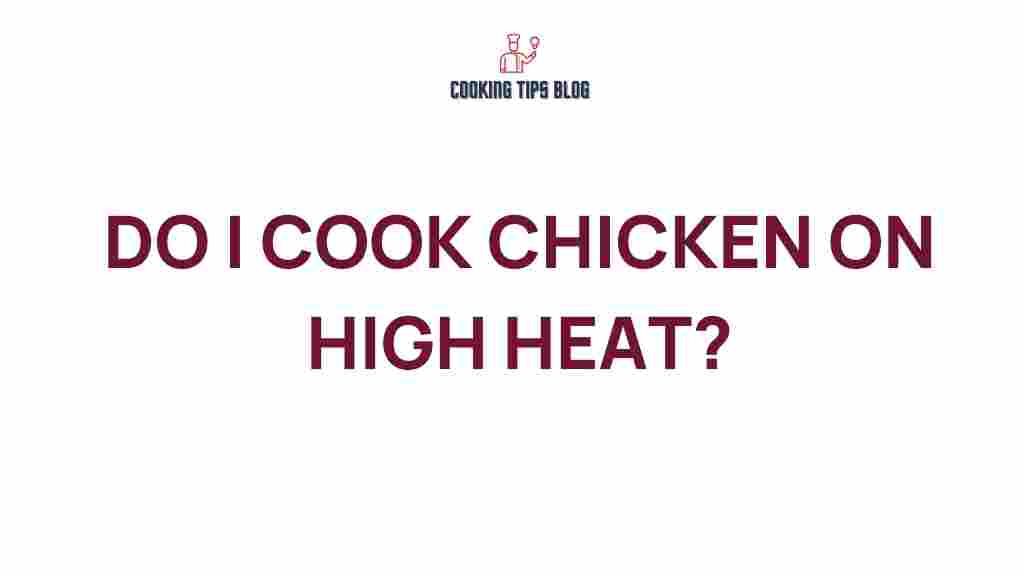The Secret to Perfectly Cooked Chicken: High Heat or Low?
Cooking chicken perfectly is a culinary art that many strive to master. Whether you’re a novice in the kitchen or a seasoned chef, understanding how to cook chicken using different heat levels can drastically affect the outcome of your dish. In this article, we will explore the best methods to cook chicken, the science behind high heat versus low heat cooking, and provide you with tips to ensure that your chicken is juicy, flavorful, and cooked to perfection.
Understanding the Basics of Cooking Chicken
Before we dive into the specifics of cooking chicken at high or low temperatures, let’s understand some fundamental concepts related to chicken preparation:
- Types of Chicken Cuts: Chicken can be cooked in various forms, including breasts, thighs, wings, and whole birds. Each cut has its unique characteristics and cooking requirements.
- Cooking Temperatures: The USDA recommends cooking chicken to an internal temperature of 165°F (74°C) for safety. This ensures that harmful bacteria are eliminated.
- Resting Time: Allowing chicken to rest after cooking is crucial. It allows juices to redistribute, resulting in a more tender and juicy final product.
High Heat Cooking: The Quick Method
High heat cooking is often associated with methods such as grilling, broiling, and pan-searing. These techniques are great for achieving a beautiful sear and caramelization on the exterior of the chicken while cooking it quickly.
Benefits of High Heat Cooking
- Speed: High heat cooking reduces the overall cooking time, which is perfect for quick weeknight dinners.
- Flavor Development: The Maillard reaction occurs at high temperatures, enhancing flavor and creating a crispy exterior.
- Texture: A quick cook can result in juicy insides while providing a satisfying crunch on the outside.
How to Cook Chicken at High Heat
Follow these steps for perfectly cooked chicken using the high heat method:
- Choose Your Chicken Cut: Opt for chicken breasts or thighs for grilling or searing.
- Marinate or Season: Enhance flavor by marinating the chicken or simply seasoning it with salt, pepper, and herbs.
- Preheat Your Grill or Pan: Ensure your grill or pan is hot before adding the chicken. This helps create that desirable sear.
- Add the Chicken: Place the chicken on the hot grill or pan. Avoid overcrowding to ensure even cooking.
- Monitor Cooking Time: Cook the chicken for 6-8 minutes on one side, then flip and cook for an additional 5-7 minutes until it reaches the recommended internal temperature.
- Rest the Chicken: Allow the chicken to rest for 5 minutes before slicing to retain its juices.
Low Heat Cooking: The Slow Method
Low heat cooking methods like braising, roasting, and slow cooking allow flavors to develop deeply and can be perfect for tougher cuts of chicken.
Benefits of Low Heat Cooking
- Flavor Infusion: Cooking slowly allows flavors to meld and develop more complexity.
- Tenderness: Low heat allows the connective tissues in the meat to break down, resulting in tender chicken.
- Versatility: You can cook larger cuts of chicken evenly and thoroughly without worrying about burning the outside.
How to Cook Chicken at Low Heat
Here’s a step-by-step guide for cooking chicken at low heat:
- Choose Your Chicken Cut: Whole chickens or bone-in thighs work well for low heat cooking.
- Season Generously: Use spices, herbs, and marinades to enhance flavor. Marinate overnight for best results.
- Preheat Your Oven: Set your oven to a low temperature, around 325°F (163°C).
- Place Chicken in a Roasting Pan: Use a roasting rack if available to allow air circulation around the chicken.
- Cook Until Tender: Roast for 1.5 to 2 hours, depending on the size of the chicken. Use a meat thermometer to ensure it reaches 165°F (74°C).
- Rest the Chicken: Let the chicken rest for 10-15 minutes before carving to ensure juiciness.
High Heat vs. Low Heat: When to Use Each Method
Choosing between high heat and low heat cooking depends on several factors:
- Time Constraints: If you’re short on time, opt for high heat methods.
- Flavor Preference: For deep flavor and tenderness, low heat cooking is preferred.
- Cut of Chicken: Lean cuts benefit from high heat, while fattier or tougher cuts shine when cooked slowly.
Troubleshooting Common Issues
Even with the best methods, there can be challenges when you cook chicken. Here are some common issues and solutions:
- Chicken is Dry: This can occur from overcooking or cooking at too high a temperature. Ensure you’re using a thermometer and adjusting cooking times.
- Undercooked Chicken: Always check the internal temperature. If it’s undercooked, return it to the heat until it reaches 165°F (74°C).
- Flavorless Chicken: Ensure you season your chicken well, considering a marinade or a spice rub for better flavor.
Conclusion
In conclusion, whether you choose to cook chicken at high heat or low heat, each method has its unique benefits and brings out different flavors and textures. Understanding when to use each technique will help you create delicious chicken dishes that are sure to impress. Remember to always check the internal temperature to ensure safety and tenderness. With practice and these tips, you’ll soon discover the secret to perfectly cooked chicken. For further cooking tips, check out this comprehensive guide on chicken preparation.
So, the next time you ask how to cook chicken, consider the heat level and the cut of meat you’re working with. Happy cooking!
This article is in the category Recipes and created by Cookingtipsblog Team
